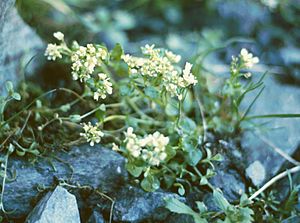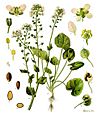Scurvy-grass facts for kids
Quick facts for kids Scurvy-grass |
|
|---|---|
 |
|
| Cochlearia officinalis subsp. pyrenaica | |
| Scientific classification |
|
| Kingdom: | Plantae |
| Clade: | Tracheophytes |
| Clade: | Angiosperms |
| Clade: | Eudicots |
| Clade: | Rosids |
| Order: | Brassicales |
| Family: | Brassicaceae |
| Genus: | Cochlearia L. |
| Species | |
|
About 25 species, see text |
|
Cochlearia (also known as scurvy-grass or spoonwort) is a group of about 30 different kinds of plants. These plants can be annuals (meaning they live for one year) or perennials (meaning they live for more than two years). They are all part of the Brassicaceae family, which also includes plants like cabbage and broccoli.
You can find scurvy-grass plants in cool and cold parts of the Northern Hemisphere. They often grow near the coast, on cliffs, or in salt marshes. This is because they can handle a lot of salt in the soil. This helps them avoid competition from other plants that can't grow in salty places. They also grow in high mountain areas and cold, treeless tundra regions.
These plants usually grow low to the ground, from 5 to 20 centimeters tall. Their leaves are smooth and rounded, shaped a bit like a spoon. In fact, the name Cochlearia comes from a Latin word for spoon! The leaves are usually 1 to 5 centimeters long and feel a bit thick or fleshy. The flowers are white and have four petals. They grow in small clusters called racemes.
Contents
Types of Scurvy-Grass Plants
There are about 30 different types, or species, of scurvy-grass. Some scientists think that a few types usually grouped under C. officinalis are actually their own unique species.
Here are some examples of scurvy-grass species:
- Cochlearia aestuaria – This is called Estuarine scurvy-grass.
- Cochlearia anglica – This is known as English scurvy-grass.
- Cochlearia danica – You might hear this called Early or Danish scurvy-grass.
- Cochlearia fenestrata – This one is Arctic scurvy-grass.
- Cochlearia groenlandica – This is Greenland scurvy-grass.
- Cochlearia officinalis – This is the Common scurvy-grass.
- Cochlearia sessilifolia – This is Sessile-leaved or Alaskan scurvy-grass.
Some plants that used to be called Cochlearia are now in different groups:
- Horseradish (Armoracia rusticana) was once called Cochlearia armoracia.
- Wasabi (Wasabia japonica) was once called Cochlearia wasabi.
There's also a plant called Cook's scurvy grass (Lepidium oleraceum). James Cook used it to prevent scurvy on his voyages. However, this plant is now very rare.
Scurvy-Grass: A Plant with a Past
Scurvy-grass is a plant you can eat, either raw or cooked. It tastes a bit like cress. Its leaves are full of vitamin C. This vitamin is very important because it helps prevent scurvy. Scurvy is a disease that happens when people don't get enough fresh vegetables in their diet.
Long ago, sailors often ate scurvy-grass when they returned from long sea trips. This helped them recover from scurvy. The ancient Roman writer Pliny the Elder (who lived from A.D. 23 to 79) wrote about a disease that Roman soldiers had in Germany. The symptoms sounded like scurvy. Pliny suggested a plant called Herba britannica, which some people think was scurvy-grass.
In 1857, a book called The Elements of Materia Medica and Therapeutics described Cochlearia officinalis as a helpful plant. It said it was good for digestion and helped with scurvy. People sometimes ate it with bread and butter, similar to how they eat watercress.
The leaves of scurvy-grass have a strong, peppery taste. It's similar to the taste of horseradish and watercress, which are related plants. Sometimes, people use scurvy-grass leaves in salads.
There is another plant called Scurvy-grass sorrel. It grows in South America and the Falkland Islands. Even though it has "scurvy-grass" in its name, it's not related to Cochlearia. However, it was also used to treat scurvy.
How Roads Help Scurvy-Grass Spread
Today, scurvy-grass can be found in many places far from the coast where it didn't used to grow. This is because of modern roads. In winter, salt is used to melt ice on roads. Scurvy-grass seeds can get stuck on car wheels. These seeds then travel long distances. When they wash off, they land in the salty soil next to the road. Since other plants can't grow well in salty soil, scurvy-grass thrives there.
Images for kids
-
Cochlearia officinalis on Bear Island, Norway
See also
 In Spanish: Coclearia para niños
In Spanish: Coclearia para niños




